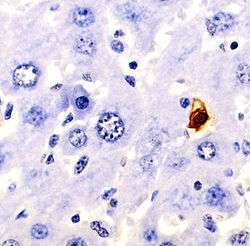TUNEL assay

Terminal deoxynucleotidyl transferase dUTP nick end labeling (TUNEL) is a method for detecting DNA fragmentation by labeling the terminal end of nucleic acids.[1]
Method
TUNEL is a common method for detecting DNA fragmentation that results from apoptotic signaling cascades.[2] The assay relies on the presence of nicks in the DNA which can be identified by terminal deoxynucleotidyl transferase or TdT, an enzyme that will catalyze the addition of dUTPs that are secondarily labeled with a marker. It may also label cells that have suffered severe DNA damage.
History
Originally described in the paper by Gavrieli, Sherman, and Ben-Sasson in 1992,[3] TUNEL has become one of the main methods for detecting apoptotic programmed cell death. However, for years there has been a debate about its accuracy, due to problems in the original assay which caused necrotic cells to be inappropriately labeled as apoptotic.[4] The method has subsequently been improved dramatically and if performed correctly should only identify cells in the last phase of apoptosis.[5][6] New methods incorporate the dUTPs modified by fluorophores or haptens, including biotin or bromine, which can be detected directly in the case of a fluorescently-modified nucleotide (i.e., fluorescein-dUTP), or indirectly with streptavidin or antibodies, if biotin-dUTP or BrdUTP are used, respectively. Often at late stages of apoptosis, adherent cells are known to detach or “pop” off. For a reliable and reproducible TUNEL imaging assay, the modified nucleotide must not only be an acceptable substrate for TdT, but the detection method must also be sensitive without bringing about any additional loss of cells from the sample.
References
- ↑ Lozano G.M., Bejarano, I., Espino, J., González, D., Ortiz, A., García, J.F., Rodríguez, A.B., Pariente, J.A. (2009). "Density gradient capacitation is the most suitable method to improve fertilization and to reduce DNA fragmentation positive spermatozoa of infertile men". Anatolian Journal of Obstetrics & Gynecology 3(1): 1-7.
- ↑ Lozano G.M., Bejarano, I., Espino, J., González, D., Ortiz, A., García, J.F., Rodríguez, A.B., Pariente, J.A. (2009). "Relationship between Caspase Activity and Apoptotic Markers in Human Sperm in Response to Hydrogem Peroxide and Progesterone". Journal of Reproduction and Development 55(6): 615-621.]
- ↑ Gavrieli Y, Sherman Y, Ben-Sasson SA (1992). "Identification of programmed cell death in situ via specific labeling of nuclear DNA fragmentation". J Cell Biol. 119 (3): 493–501. doi:10.1083/jcb.119.3.493. PMC 2289665
 . PMID 1400587.
. PMID 1400587. - ↑ Grasl-Kraupp B, Ruttkay-Nedecky B, Koudelka H, Bukowska K, Bursch W, Schulte-Hermann R (1995). "In situ detection of fragmented DNA (TUNEL assay) fails to discriminate among apoptosis, necrosis, and autolytic cell death: a cautionary note". Hepatology. 21 (5): 1465–8. doi:10.1002/hep.1840210534. PMID 7737654.
- ↑ Negoescu A, Lorimier P, Labat-Moleur F, Drouet C, Robert C, Guillermet C, Brambilla C, Brambilla E (1996). "In situ apoptotic cell labeling by the TUNEL method: improvement and evaluation on cell preparations". J Histochem Cytochem. 44 (9): 959–68. doi:10.1177/44.9.8773561. PMID 8773561.
- ↑ Negoescu A, Guillermet C, Lorimier P, Brambilla E, Labat-Moleur F (1998). "Importance of DNA fragmentation in apoptosis with regard to TUNEL specificity". Biomed Pharmacother. 52 (6): 252–8. doi:10.1016/S0753-3322(98)80010-3. PMID 9755824.
External links
- TUNEL at the US National Library of Medicine Medical Subject Headings (MeSH)